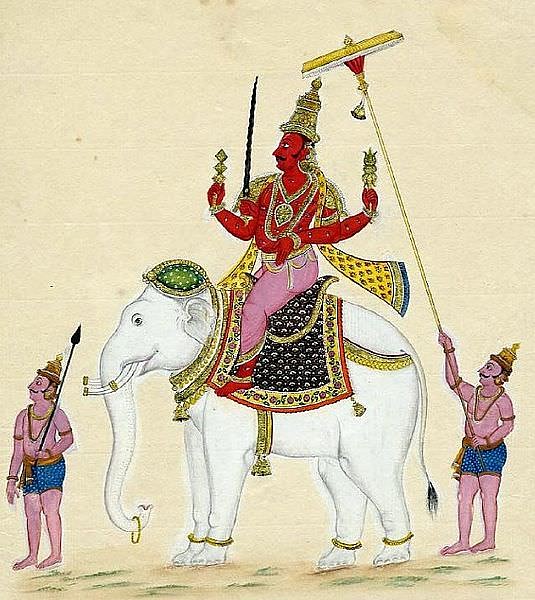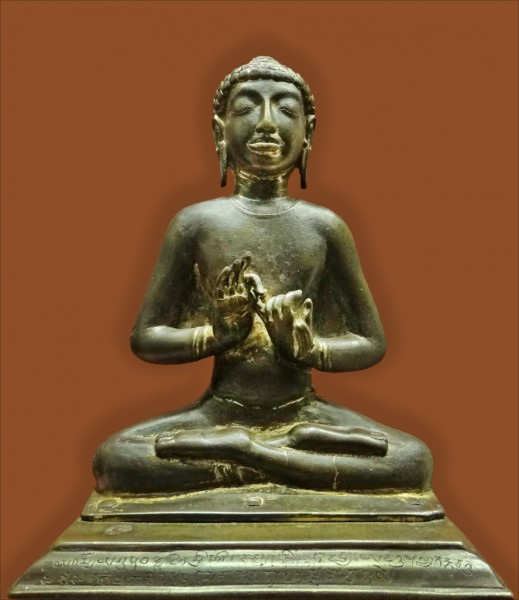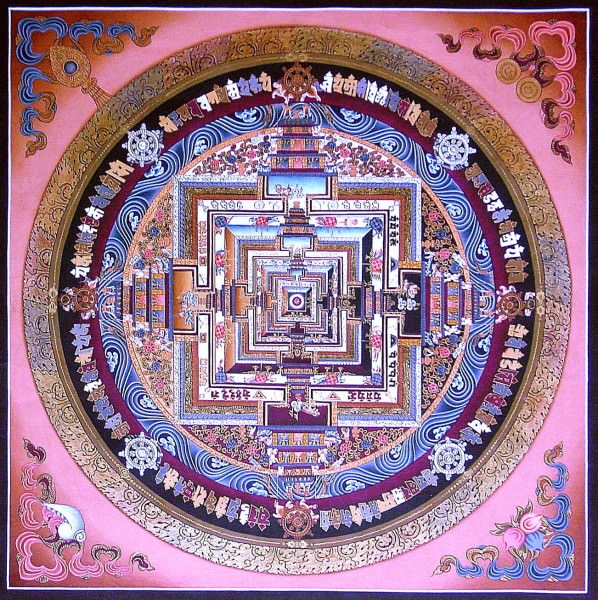Indra › Esoteric Buddhism » Ancient origins
Articles and Definitions › Contents
- Indra › Who Was
- Esoteric Buddhism › Antique Origins
Ancient civilizations › Historical and archaeological sites
Indra › Who Was
Definition and Origins

The anthropomorphic god Indra was the most important god in the Vedic religion and he later became a major figure in Hinduism and an important deity in Buddhism, Cham and Chinese tradition. For the Aryas he was their national god and he was regarded as the protector of the military aristocracy and the Kshatriyas warriors. The formidable thunderbolt-wielding Indra strikes an imposing figure but as king of the gods he is generally benevolent, being generous to his worshippers, guaranteeing peace and prosperity and delivering beneficial rainstorms to end droughts. He can also be called upon in times of war to give support with his divine weapons and favourable intervention. In later tradition Indra is transformed from a worshipped god into a mythological figure involved in various, sometimes unflattering, adventures whilst gods such as Vishnu and Shiva replace him at the head of the Hindu pantheon. Nevertheless, Indra continued to be associated with storms, rain and the cardinal point East.
GOD OF THUNDER & STORMS
In the Hindu creation myth Indra was born (along with his brother Agni ) from the mouth of the primordial god or giant Purusha whose various other body parts gave birth to the other members of the Hindu pantheon. These new gods then brought order to the cosmos and Indra, seated on his throne within the storm clouds of the svarga or third heaven is ruler of the clouds and skies alongside his wife Indrāni. In Indian mythology the clouds are equated with divine cattle and the sound of thunder during storms is Indra fighting with the demons who are forever trying to steal these celestial cows. In addition, the rain is equated with Indra milking his divine herd and the god is seen as a protector of earthly cattle belonging to his worshippers. Indra encompasses and controls the universe, balancing the earth in the palm of his hand and manipulating it according to his whim.He also created the rivers and streams by shaping the mountains and valleys with his sacred axe.
Indra has a favourite companion, his pet ape Vrishakapi, but his fondness for the creature did once incur the jealous wrath of Indrāni who then displayed amorous intentions towards Vrishakapi which were reciprocated and when the couple were discovered by Indra, the angry god drove the animal away. However, the tables were turned when, later, Indra himself was discovered in the arms of Vrishakapi's wife by his once faithful pet. Thus being equal in their unfaithfulness the pair's great friendship was restored.
INDRA WAS KNOWN FOR HIS FONDESS FOR SOMA, THE ALCOHOLIC ELIXIR.
Indra, noted for his virility, was unfaithful to his wife on several other occasions when the god often disguised himself in order to better seduce his victims. One famous object of the god's seemingly insatiable desire was the wife of the sage Gautama.Sometimes Indra did though pay a heavy price for his amorous adventures, for example, he was once so brutally cut to pieces by an outraged husband that the gods struggled to put him back together again. When they did finally manage it they found a rather important piece of him missing and so were forced to complete the god using the member of a ram.
THE ADVENTURES OF INDRA
Indra appears many times in the Vedic scripts, especially the Rig Veda where he has all sorts of weird and wonderful adventures. In the Sanskrit epic Mahabharata, Indra is the father of the hero Arjuna and he manages to win the magic armour that would make his son invincible. Indra was involved in a famous fight against the Dāsas (or Dasyus) and in another famous adventure he swiftly dealt with Vala who one day was bold enough to steal the god's herd of sacred cattle. Vala cleverly hid his prize in the depths of a mountain but was tracked down by Indra's servants the Maruts or Rudras (storm gods), then, one thunderbolt from Indra was enough to split the mountain in two and release the herd who were safely escorted back to the heavens.

Indra Sava - Ellora Caves
Indra's great friend and protégé Kutsa fought with Sushna ('the Witherer') and at the end of the day when the two were still in combat and darkness seemed about to halt the proceedings Indra delayed the sunset by yanking off a wheel of the sun's chariot. Indra then gave the wheel to Kutsa who used it as a devastating weapon to win the fight.
Indra is, on occasion, portrayed in a less than favourable light in his adventures, for example, he is known for his fondness of the alcoholic elixir drink soma which he does not always take in moderation and so he sometimes suffers from its after-effects.However, the helpful Ashvins gods and the goddess Sarasvati are always on hand to administer an antidote taken from the body of a demon and restore the god to his senses.
Perhaps the most celebrated exploit involving the god is his battle with the demon Vritra. This demon, also known as the Enemy, had transformed himself into a fearsome snake with no less than 99 coils. Unfortunately for local farmers these tremendous coils were blocking up the rivers and streams and causing a great drought. So horrifying was Vritra that none of the gods dared intervene and it was only Indra who found the courage, fortified with soma, to slay the beast with one of his thunderbolts. As a result of this episode he won great favour among the other great gods and one of Indra's surnames became Vritrahan, meaning the 'slayer of Vritra'.

Indra, Java
IN OTHER RELIGIONS
Indra is known as Sakra in Buddhism and he rules the 33 gods. In Cambodian tradition he is known as Pah En the god of the sky and he is the most popular of the gods. He is considered to live atop Mt. Meru or Prah Sumer along with his servants the Yeaks (Yashas), fearsome ogres with fangs and red eyes who can transform themselves at will into any shape they please. In the Cham religion of Vietnam he is also the god of thunder and rides a white elephant. In Chinese tradition he is identified with the god Ti-shi. Finally, the god is still worshipped today in the Rajasthan region of India in the festival of Inder Puja which calls for rains to prevent the frequent droughts prevalent in this desert state.
REPRESENTATIONS IN ART
Indra is frequently portrayed wielding a thunderbolt ( vajra ) but he may also carry the chakra discus, an ankusa or elephant goad and an axe, the tanka. He is often shown riding his white elephant Airāvata who was born from the churning of the seas when the world was created. In later Buddhism the god's thunderbolt becomes a diamond sceptre, the Vajrayana.
Esoteric Buddhism › Antique Origins
Definition and Origins

Esoteric Buddhism is also known by the terms Mantrayana and Tantra. These teachings are secret and not available to just anyone, whereas Exoteric teachings learned from books are accessible to everyone. The student of Esotericism (Jap: mikkyo ) must have received proper initiation from a master or guru from a valid lineage of masters before him or her. Esoteric teachings have a mystical element, and Exoteric teachings are of a philosophical nature.
In Esotericism, the practitioner creates a special bond with a guardian Buddha, Bodhisattva, or deity during their initiations and eventually becomes spiritually united with that being. In Tibetan Buddhism (Vajrayana), this strongly characteristic practice is referred to as 'Guru Yoga.' Ritual formulae, such as mantras, mudras, meditation, and mandalas are essential devices enabling a shortcut to enlightenment.
FIRST APPEARANCE & EVOLUTION
Its roots are in northern India, as are all schools of Buddhism, originating with the enlightenment (Skt: bodhi ; Jap: satori or kensho ) of the Historical Buddha, Shakyamuni under the Bodhi tree in Bodhgaya, present-day Bihar. Buddha deliberately forbade the fashionable magic and overt mystical ritualism of the Brahmins and Hindus of the time to seek benefit in the form of health, wealth, and other basic human needs. In fact, he strove to set new practical goals of spiritual liberation by means of self-awareness for the whole of humanity, insisting that seekers quit their role as householders, take vows, and enter a monastery. However, several hundred years after Shakyamuni's death, people missed the excitement of dramatic rituals and mantras, so priests searched for other routes to enlightenment, and people, in general, were not willing to live apart from their families.
Then, Brahmanism and Hinduism witnessed a revival, and the mystical element of Buddhism again became fashionable. It was Nagarjuna, in the 2nd century CE, the first Indian Buddhist living in southern India, who developed the Buddhist Middle Way which people were searching for. He is known as the probable founder of Esoteric Buddhism which systematised all the different practices uniting them in something more recognisable to us today as Buddhism.
The Esoteric secrets, rituals, and symbols evolved to enable the student to communicate with a spiritual Buddha, the Dharmakaya, the true nature of the Universe and to aspire for rapid enlightenment. In Exoteric practice, the focus remained on the historical or physical body of the Buddha, or Nirmanakaya, and enlightenment lay beyond the horizon in another lifetime.
This shift to the spiritual was achieved by moving outside the intellectual limitations of space and time. The Dharmakaya of Buddha is represented by the great Vairochana Buddha, (also spelt Vairocana, Jap. Dainichi Nyorai ), the Illuminator and embodiment of Awareness of the Continuum of Reality. In Esotericism this became the central Buddha form like the sun whose rays touch everywhere to stimulate growth.
THE SECRETS OF ESOTERICISM
This oral tradition of handing on teachings, along with initiations into certain levels of knowledge made in person by a guru, is perhaps the hallmark of Esotericism. Connection with the Dharma Stream is so crucial to the furthering of faith and to the protection of the teachings in Esotericism, as is the purification of body, speech, and mind in one's daily life.
THE ORAL TRADITION OF HANDING ON TEACHINGS, ALONG WITH INITIATIONS INTO CERTAIN LEVELS OF KNOWLEDGE MADE IN PERSON BY A GURU, IS PERHAPS THE HALLMARK OF ESOTERICISM.
The notion that all sentient beings possessed Buddha Nature which could be uncovered intensified. This generated more lay orders and eradicated gender discrimination.
The emergence of Esoteric Buddhism in Japan is a vast subject, but briefly, Kukai, (Kobo Daishi) recognised as the 8th Patriarch of Esoteric Buddhism, embraced the richness of ritual and symbolism for his nation. While studying in China, he was recognised and initiated by Huiguo, the sole Chinese master of the teachings given by Amoghavajra, the great Indian mystic, at Qinglong-si temple in Chang'an, in 804. He was conferred with the title of Vairochana, the Great Illuminator (Jpn: Namu Henjo Kongo ). As a consequence, Shingon Buddhism was established by Kukai, Japan's first fully initiated great Master.
THE ORIGIN OF RITUALS OF ESOTERICISM
Ancient Indians believed wholly in the supernatural and the natural world. They especially envied the characteristics of some animals. The peacock was one such creature they revered and desired to emulate, especially when they realised it could eat poisonous creatures and survive. They were gifted at communicating with the spiritual or invisible world, so they developed mantras (spoken or chanted formulae) which emulated the peacock and brought the animal god closer to the human world.Then the concept of 'poisons' in general came to represent negative aspects of the human mind which required an antidote, mantras and invocations becoming viewed as antidotes.
The Homa (Jpn: Goma ) ritual, Brahmin in origin, is one of the most dramatic of Esoteric rituals and originates with the making of offerings to the heavens and the god of fire, Agni.
Body, Speech, and Mind as represented by the Nirmanakaya, Sambhogakaya and the Dharmakaya are united in a single entity in Esoteric Buddhism represented by mudra, mantra, meditation, and mandala. According to Kukai,
These are symbolised in the elements, the syllables, wisdoms, and so on, in an always fluid whole contained in the Four Mandalas, the three-secrets empowerment, the 5 bodhisattva wisdoms which make a perfect mirror to reflect true enlightenment. (Yamasaki, 106)
MUDRA
Representing the Body, the use of the hands in gassho (Jpn: Skt; anjali, Chi: ho-chang ) palms pressed together and fingers long is a highly significant gesture which aids entering and self-entering between oneself and the Buddha. It is the main mudra known as 'dharmakaya mudra.' Buddha images show a variety of significant hand mudras, for example, the earth-touching mudra fearlessly calling the Earth to witness the Buddha's enlightenment and the Dharmachakra mudra (the wheel of Dharma) in which the first finger and thumb of each hand touch to form a circle, and so on. Mudras are said to be like a seal which leaves an identical impression on clay or paper, imprinting certain qualities which will change the practitioner.

Dharmachakra Mudra
MANTRA
Representing Speech, the recitation or chanting of mantras. Mouths should be kept pure and speech Buddha-centred in order to chant and to reach the spiritual world. In fact, concentrated recitation of mantric syllables, according to Kukai, "employs the sound, the image, and the meaning of the syllable" (Yamasaki, 116). And as he wrote in The Secret Key to the Heart Sutra, "One syllable embraces a thousand truths, manifesting universal reality in this very body."
Originally, in the Indian Buddhist tradition, silent recitation was said to have a thousand times greater effect than the voiced;and in advanced meditation, the practitioner learns to voice the sound within the mind. Kukai taught five methods of mantra recitation. The first involves the visualisation of a conch shell above a lotus within the mind and then the projection of the voice through the imagined conch shell. So the Esoteric practitioner evokes a level of mind in which the practitioner becomes the chant itself, as the deity or guru and the practitioner exist in inseparable unity.
MEDITATION
Representing the Mind, the original goal of exoteric meditation was to achieve a state of 'no mind, no thought' (Skt: asphanakaSamadhi; Jap. munen muso ). However, in the Dainichi- kyo, one of the two principal sutras of Esoteric Buddhism, it is stated that visualisation may employ images of Buddhas, Bodhisattvas, deities, human beings or non-human beings; in other words, any forms are embodiments of the universal self.
Mahayana Buddhism, in general, developed many practices of meditation focusing on virtues and powers, as well as the appearance of the Buddhas and deities. An early Esoteric sutra, the Kanjizai Bosatsu Tabatari Zuishin Darani- kyo , which focuses on the Bodhisattva Kannon, was the first to systematise so-called 'three secrets' visualisations. The practitioner first forms hand mudras and visualises Kannon as a mantric 'seed-syllable,' then as a symbolic object and finally in human form. In this way, the abstract gradually becomes concrete and the practitioner can relate directly to it.
MANDALA
This is a sacred or circular diagram (occasionally oblong in Japan), also believed to represent the Body, Speech, and Mind of a Buddha (sometimes specifically one of these), usually used during initiations. Mandalas are said to exist in many dimensions as they convey things which cannot be conveyed in writing. The word 'mandala' means 'that which has essence' roughly translated. Buddhguhya, the 8th-century master, wrote that the 'essence' refers to that of the Buddha's enlightenment itself so that the mandala is the realm.

Tibetan Mandala
ESOTERIC SUTRAS
The three principal sutras (scriptures) of Esotericism are the Mahavairochana Sutra (Jpn: Dainichikyo ), The Diamond Peak Sutra (Jpn: Kongochokyo ), and the Mahaparinirvana Sutra delivered from the deathbed of the Buddha. These are the core works of the three streams of Esotericism in Japan; the Shingon School, the Tendai School founded by Kukai's peer Saicho, and the Shinnyo School founded by Shinjo Ito more recently. The first two were transmitted from India around the 8th century CE by fearless monks travelling the Silk Roads. The Mahaparinirvana Sutra arrived in China in three different versions: the Hokkien Text in 418 CE, the Northern Text in 421 CE, and the Southern Text in 436 CE.

Chinese Diamond Sutra
These three sutras hold the secrets of the Universe. The Mahaparinirvana sutra is "like a healer who has a secret cure that contains all possible medical treatments" and "like the most delicious milk having eight different flavours." The Dainichikyo and the Kongochokyo contain the essence of the main Esoteric Mandalas.
ESOTERIC BUDDHISM TODAY
It is almost impossible to assess how many people practice Esoteric Buddhism worldwide, but it is certain that the main schools are all in the Mahayana tradition, ie. from the 2nd century CE onwards. Tibetan Buddhism (Vajrayana or Tantra) is found in Tibet, Bhutan, northern India, Nepal, southwestern China, Mongolia, Russia, and a variety of western countries and has existed since the 8th century CE. In China, three Indian teachers, Subhakarasimha, Vajrabodhi, and Amoghavajra brought it to great popularity in the Tang Dynasty (618-907 CE), and today many schools there share the same doctrines as Japanese Shingon. In Japan, Shingon Buddhism is exclusively esoteric, and Tendai Buddhism uses many esoteric practices. Shugendo, mountain asceticism in which practitioners rid themselves of their human ego by exposing themselves to the elements with waterfall training and hot candle skin burning, was founded in 7th-century CE Japan and survives today as a combination of Esoteric Buddhism, Shinto (the national religion ), and Taoist influences.
LICENSE:
Article based on information obtained from these sources:with permission from the Website Ancient History Encyclopedia
Content is available under License Creative Commons: Attribution-NonCommercial-ShareAlike 3.0 Unported. CC-BY-NC-SA License